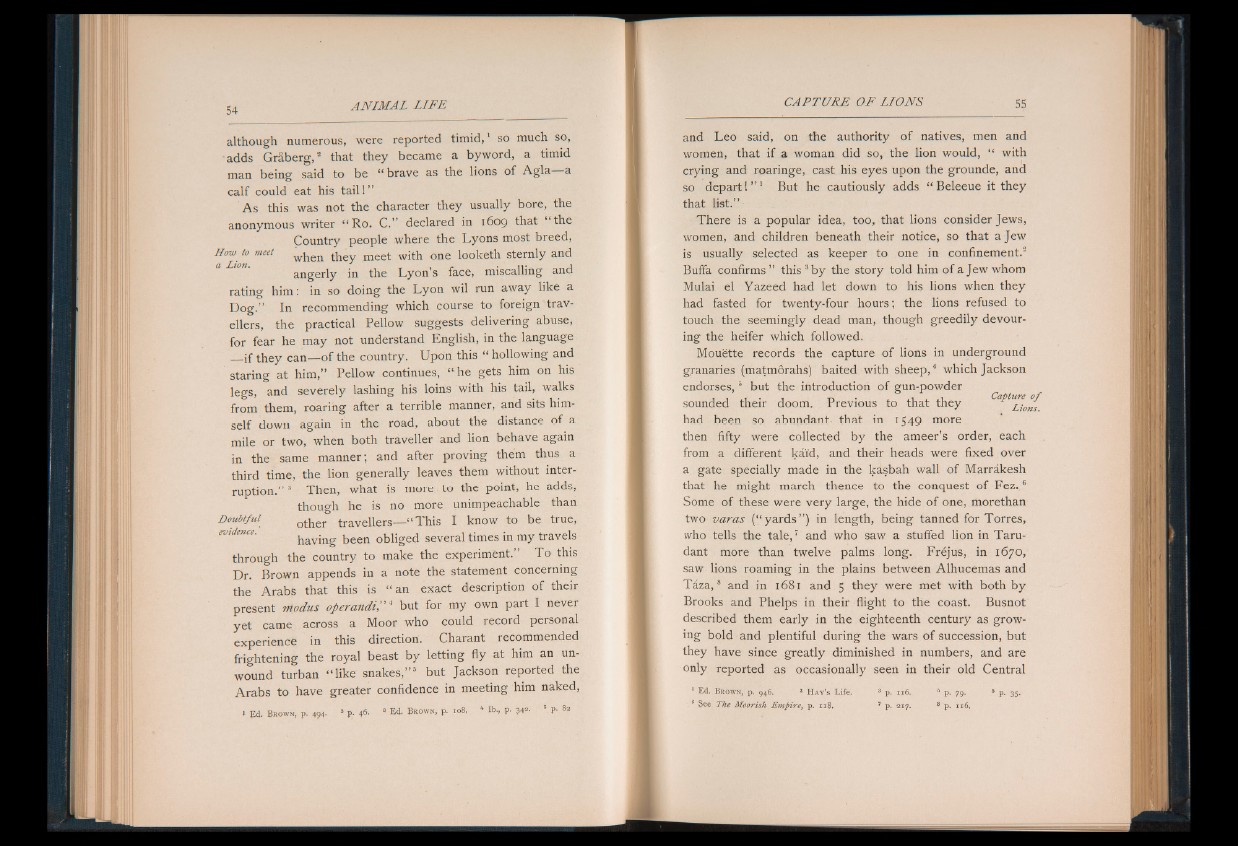
although numerous, were reported timid,1 so much so,
adds Gr&berg,2 that they became a byword, a timid
man being said to be “ brave as the lions of Agla a
calf could eat his tail 1 ”
A s this was not the character they usually bore, the
anonymous writer “ Ro. C.” declared in 1609 that “ the
Country people where the Lyons most breed,
How to meet when they meet with one iooketh sternly and
angerly in the Lyon’s face, miscalling and
rating him: in so doing the Lyon wil run away like a
D og .” In recommending which course to foreign travellers,
the practical Pellow suggests delivering abuse,
for fear he may not understand English, in the language
— if they can— of the country. Upon this “ hollowing and
staring at him,” Pellow continues, “ he gets him on his
legs, and severely lashing his loins with his tail, walks
from them, roaring after a terrible manner, and sits himself
down again in the road, about the distance of a
mile or two, when both traveller and lion behave again
in the same manner; and after proving them thus a
third time, the lion generally leaves them without interruption.”
3 Then, what is more to the point, he adds,
though he is no more unimpeachable than
Doubtful other travellers— “ This I know to be true,
having been obliged several times in my travels
through the country to make the experiment.” To this
Dr. Brown appends in a note the statement concerning
the Arabs that this is “ an exact description of their
present modus operand i"4 but for my own part I never
yet came across a Moor who could record personal
experience in this direction. Charant recommended
frightening the royal beast by letting fly at him an unwound
turban “ like snakes,” 5 but Jackson reported the
Arabs to have greater confidence in meeting him naked,
» Ed. Brown, p. 494- * P; 46- 3 Ed. Brown, p. 108, * lb., p. 34*- 5 P- 82
and Leo said, on the authority of natives, men and
women, that if a woman did so, the lion would, “ with
crying and roaringe, cast his eyes upon the grounde, and
so departí” 1 But he cautiously adds “ Beleeue it they
that list.”
There is a popular idea, too, that lions consider Jews,
women, and children beneath their notice, so that a Jew
is usually selected as keeper to one in confinement.3
Buffa confirms ” this 3 by the story told him of a Jew whom
Mulai el Yazeed had let down to his lions when they
had fasted for twenty-four hours; the lions refused to
touch the seemingly dead man, though greedily devouring
the heifer which followed.
Mouétte records the capture of lions in underground
granaries (matmórahs) baited with sheep,4 which Jackson
endorses,5 but the introduction of gun-powder
Cat ture o f
sounded their doom. Previous to that they Lions
had been so abundant that in 1549 more
then fifty were collected by the ameer’s order, each
from a different káid, and their heads were fixed over
a gate specially made in the kasbah wall of Marrákesh
that he might march thence to the conquest of F e z .6
Some of these were very large, the hide of one, morethan
two varas (“ yards” ) in length, being tanned for Torres,
who tells the tale,7 and who saw a stuffed lion in Taru-
dant more than twelve palms long. Fréjus, in 1670,
saw lions roaming in the plains between Alhucemas and
Táza,8 and in 1681 and 5 they were met with both by
Brooks and Phelps in their flight to the coast. Busnot
described them early in the eighteenth century as growing
bold and plentiful during the wars of succession, but
they have since greatly diminished in numbers, and are
only reported as occasionally seen in their old Central
1 E d . B r o w n , p. 946. 2 H a y ’s L i f e . 3 p . 1 16 . 4 p. 79. 5 p . 35,
6 § e e The Moorish Empire, p . 1 18 . 7 p . 2 1 7 , 8 p. 1 16 ,